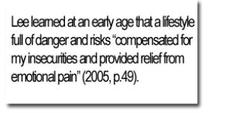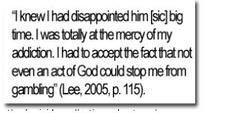Born to Lose (2005) by Bill Lee details the author’s life-long struggle with gambling problems. Lee describes how he secluded himself from his family and proceeded to gamble away savings and even his son’s college funds. This book provides a case study of the chain of events involved in the development of an addiction, as Shaffer et al.(2004) described in a recent article. The syndrome model Shaffer et al. propose suggests that a complex, multidimensional process underlies the development and maintenance of harmful, excessive behavior patterns. The syndrome model suggests that specific predisposing factors (e.g., neurobiological, psychological and social) lay the groundwork for the development of addiction. Refer to WAGER 10(1) for a more in-depth look at this model. In his book, Lee explains how many life experiences and interactions influenced the development of his addiction and its associated symptoms.
Lee’s early life experiences could have predisposed him to develop gambling problems. He writes that gambling has been a part of his life since before birth: a family legacy was established when his grandfather “sold” his father to pay a gambling debt in China. His mother told him the story after he was hustled in a poker tournament at the age of sixteen. She told him because she wanted to warn him about his “inherited” gambling proclivities. Dealing with an abusive family and a traumatic childhood environment, Lee learned at an early age that a lifestyle full of danger and risks “compensated for my insecurities and provided relief from emotional pain” (2005, p.49). Perhaps as a way of self-medicating his emotional and psychological pain, he turned to street crime and gambling. Using the syndrome model one could look at his underlying vulnerabilities combined with social and psychological stressors as a strong factor in the development of his gambling problem.
Lee began engaging in and benefiting emotionally from gambling at an early age. He developed his first gambling problems playing cards with the neighborhood kids. As a child, Lee became enthralled with anything remotely related to wagering, such as playing “knock the baseball card down” and betting classmates that a certain test would be given. Lee explains that, even in elementary school, “For reasons that baffled me at the time, I refused to quit when I was ahead and chased after my cards when I lost” (Lee, 2005, p.22-23). Many times in his life, he would gamble away his savings and more. Despite very serious consequences, Lee gained a great amount of satisfaction with repeated exposure to gambling, and the rush kept him coming back. Shaffer et al. (2004, p. 368) describe such positive feelings as an influential reason why players continue to gamble or drink excessively despite adverse consequences.
Lee continued experiencing serious troubles in high school when, at the completion of a card game, he owed schoolmates $200 dollars. After high school he lost $800 in the stock market. Later, he lost $9,000 during a single day of casino gambling. He writes, “At this point, my credit cards were maxed out to the tune of $18,000 and I owed $20,000 to my credit union” (Lee, 2005, p. 89). These repeated episodes of gambling losses were followed by concerns about his preoccupation with gambling, but these concerns were not sufficient to stop Lee’s gambling. Soon he relapsed to excessive patterns of gambling once again. This cycle is consistent with Shaffer et al.’s suggestion that addiction syndrome is “recursive” in nature. Gambling or other addiction problems create new vulnerabilities and stimulate the development of new problems and symptoms, including other addictive behavior patterns (Shaffer et al., 2004, p. 368).
The second half of the book deals primarily with Lee recognizing his problem and learning to deal with it despite numerous setbacks, heartaches, and relapses. After ignoring even a supposed divine warning about his gambling problems, he writes, “I knew I had disappointed him [sic] big time. I was totally at the mercy of my addiction. I had to accept the fact that not even an act of God could stop me from gambling” (Lee, 2005, p. 115). It was not until Lee received a variety of treatments that he began to recover in earnest. Lee received medication and treatment for his OCD from his therapist, worked to resolve several family problems, and gained a social support system from GA that he did not previously have. As a way of treating addiction syndrome, Shaffer et al. suggest using such a “cocktail” approach, which targets multiple symptoms and co-occurring disorders (Shaffer et al., 2004, p. 372). This “cocktail” approach might have been the catalyst that started Lee on the road to long-term recovery.
Although his writing is not stylized or flashy, Lee’s prose speaks to the depth of despair that disordered gamblers must confront. The decades ago demonstrate the extent of his preoccupation with gambling activities at the time. As with most addictive behavior patterns, frequent relapses disturbed Lee’s path to recovery. Nevertheless, his impressive rebound from debt to financial security can provide hope to those working toward recovery from addiction. In his life, addictive tendencies in his family might have combined with an emotional vulnerability that he developed as a traumatized child struggling with OCD. Gambling seemed to provide an escape from hardships throughout his life. The effective solution was a combination of treatments for his varying problems.
Throughout the book, Lee keeps the text intensely personal. By the end, he lets the reader observe how a former excessive gambler can learn to manage life stressors and control gambling problems. While it probably would not be read for its writing style, this book is an interesting and quick read about an excessive gambler’s life. Moreover, Lee reminds us of how many complex factors influence the development of, maintenance of, and recovery from addiction syndrome.
What do you think? Comments can be addressed to Michael Stanton.
References
Lee, B. (2005). Born to Lose: Memoirs of a Compulsive Gambler. Center City, Minnesota: Hazelden.
Shaffer, H. J., LaPlante, D. A., LaBrie, R. A., Kidman, R. C., Donato, A., & Stanton, M. V. (2004). Toward a syndrome model of addiction: Multiple manifestations, common etiology. Harvard Review of Psychiatry, 12(6), 367-374.






